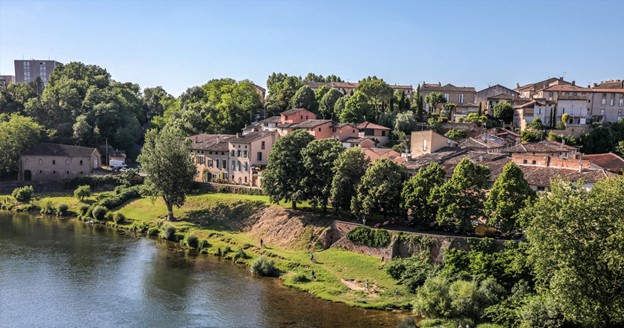If someone were to ask, “Where should I go to taste the best California wines?” most of us Americans would probably point the questioner to the Napa Valley. But if that question was applied to France, the only reasonable answer is “It depends”.
Virtually every part of France produces wine. Burgundy is renowned for wines made from Pinot Noir and Chardonnay. In the region around the city of Bordeaux, the grapes are Cabernet Sauvignon, Merlot and Semillon. The Rhône Valley produces Grenache, Syrah, Roussanne and Marsanne grapes. Which is the best? Well, it depends on what you like.
The town of Gaillac in Southwest France. Photo courtesy of Ville de Gaillac.
And we could complicate matters by pointing to Riesling and Gewurztraminer in Alsace, Gaillac (made of Duras and Fer grapes) in the Southwest and Malbec in Cahors (known locally as Côt). If all of this is confusing, it needn’t be. Winemaking in France arose from many different histories and ecosystems. If you’d like to travel around France, just enjoy whatever you find that’s produced locally.
We Americans are used to a lot of these different grapes grown in the same general vicinity. (Well, maybe not Duras or Fer.) But the differences are not as deeply rooted in the culture of each location. So if you’re wine tasting in France, keep a few things in mind.
- There are laws in France requiring certain regions to make wine from certain grapes, and in certain blends, if they want to be able to claim AOC (appellation d’origine contrôlée) status. So, while you will find some Cabernet Sauvignon in Russian River, you won’t be able to do the same in the Burgundy’s Côte d’Or, for example.
- There are regions where vignerons (French for winemakers) grow the “wrong” grapes. For example, Château Canet in Minervoix makes Merlot and Malbec (but can’t label them Minervoix, because different grapes are required there). For another example, Mas de Gourgonier in Les Baux de Provence has a Cabernet Sauvignon/Syrah blend, which is fine in Australia but not in France. If you don’t get hung up on the rules, you can enjoy some interesting alternatives while you are in various parts of France.
- You can take a chance with some grapes you’ve never heard of. We’ve already mentioned the virtually unknown grapes in Gaillac wine, which is readily available in Toulouse. There’s Melon grapes in the Jura mountains, Auxerrois in Alsace or Chasselas in the Savoie. You may never get another chance to taste wines made from these grapes, so if you’re in the area, give them a try.
- On the other hand, you might find a familiar wine by a different name. In the 1860s, Francois Durif, a French botanist, had a vineyard growing Peloursin and Syrah. The two cross-pollinated and he found himself with a different grape entirely. He made wine from it and named it after himself. If you happen to find a bottle of Durif, it may seem familiar, because in the US we call it Petite Sirah.
The overall messages are that a) If you travel in France you’ll encounter great wine wherever you go. b) Enjoy what each region is famous for, but keep your mind (and your mouth) open for new and unexpected experiences.
